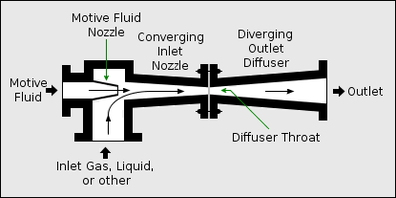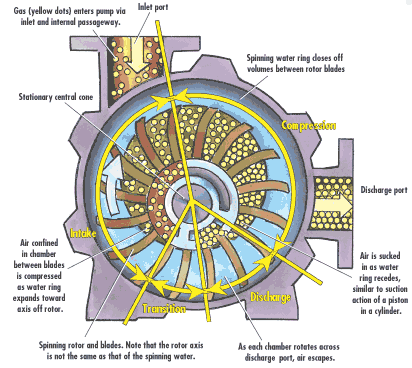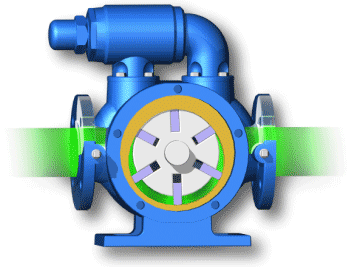-
Vacuum systems
Definition
It is a system which maintains the pressure inside a chamber under the value of the atmospheric pressure.
Function
In conventional power plants, the pressure inside the condenser must be maintained at a very low value, since the cycle efficiency increases with the temperature difference between the hot source and the cold source. A pressure of saturated vapor of 37.79 mbar corresponds to the temperature of 28 °C. The second function of the vacuum system is to extract the non-condensable gases contained in the steam at the turbine exhaust, as their accumulation in the chamber breaks down the vacuum.
The steam ejectors ensure a rapid decrease of the pressure within the enclosure till a 100 millibar vacuum, then the vacuum pumps are turned on. In normal operation, only the pumps operate to keep the vacuum at prescribed value.
Components of vacuum system
A vacuum system includes:
- vacuum pumps and ejectors,
- piping and isolating valve equipped with water seal gasket,
- a vacuum-breaker valve of the under-vacuum chamber,
- instrumentation: pressure gauge, pressure regulator, thermometer.
Suppliers are currently delivering racks on which are set up the various equipment.
Different types
The following equipment are installed in thermal power plants:
- steam ejectors,
- Liquid ring vacuum pump
- Vane vacuum pumps
A steam ejector, steam injector is a type of pump that uses the Venturi effect of a converging-diverging nozzle to convert the pressure energy of a motive fluid to velocity energy which creates a low pressure zone that draws in and entrains a suction fluid. After passing through the throat of the injector, the mixed fluid expands and the velocity is reduced which results in recompressing the mixed fluids by converting velocity energy back into pressure energy. The motive fluid may be a liquid, steam or any other gas. The entrained suction fluid may be a gas, a liquid, a slurry, or a dust-laden gas stream.

The impeller is the only moving part inside the pump. It rotates without contact within the pump casing. A rotating liquid ring seals the impeller on the front and seals its blades against one another. In order to keep the liquid ring stable, liquid is also permanently sucked into the compression chamber and is output together with the conveyed gas. The excentrical arrangement of the impeller within the casing creates variable compression chambers between the impeller blades during rotation, which causes the conveyed gas to be compressed within a full revolution.Since the pumps always create a pressure difference during operation, they can also be used as compressors when pumping gas from the surrounding atmosphere. The extraction flow of these pumps decreases with the partial pressure of steam.

Pressure increase by volume reduction is the principle behind rotary vane operation. In a cylindrical housing a rotor is positioned eccentrically so that it is on the top almost touching the cylinder. Rotor blades or vanes as they are called, are positioned inside rotor slots. When the rotor starts turning, due to centrifugal force the blades are thrown out and slide against the internal surface of the cylinder. In this way a cell is formed between two blades with a volume that changes constantly during rotation. Air enters from the inlet port into a cell until the rear blade reaches the far end of the inlet port. At this point the cell has achieved its maximum air volume. As the cell then moves away from the port its volume becomes smaller and smaller, the air is thus compressed and the pressure rises. This continues until the pressure in the cell exceeds that in the pressure chamber and the compressed air then exits through the outlet port. Some models are fitted with exhaust valves which stop the backflow of this discharged air if the maximum pressure has been reached. In a vacuum pump the process is similar, but the cell gives decreasing pressure, and the chamber is at atmospheric pressure. With pressure-vacuum pumps the lower end of the inlet port(s) for the vacuum is moved forward. The cell can now be filled through second inlet. To avoid impairing the vacuum, this second inlet port is located about one cell segment away from the main suction port. The ratio between vacuum and pressure capacities can be influenced by the choice of inlet port.


